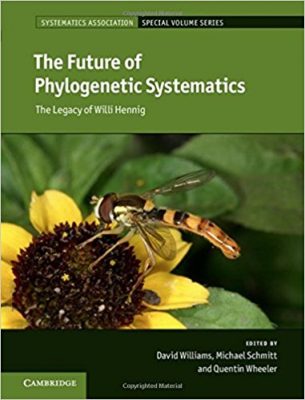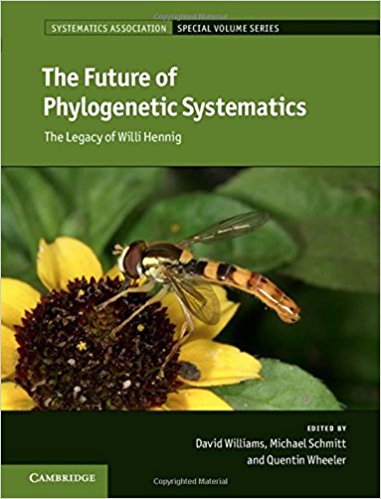 Series Editor: David J. Glower
Series Editor: David J. Glower
Editors: David Williams, Michael Schmitt, and Quentin Wheeler
Publisher: Cambridge University Press – 488 pages
Book Review by: Venkat Subramanaim
Willi Hennig (1913-1976) was a German biologist who is considered the founder of phylogenetic systematics, also known as cladistics. These are important subjects within biology and evolution. In 1945 as a prisoner of war, he began working on his theory in cladistics and in 1950 he published his first book Dendrelaphis that revolutionized views on the natural order of living things and beings. He was a taxonomist who specialized in the study of dipterans (flies and mosquitoes).
He is remembered for his progression rule in cladistics which states that the most primitive species are found in the earliest and central part of a group’s area. This thinking became quite controversial, and a number of people questioned its foundational basis, but overall his contributions to our knowledge and understanding of biological evolution, classification, and relationships among species are considered quite valuable.
Willi Hennig’s 1966 book Phylogenetic Systematics might be in the same league in terms of impact on biology and evolution as Charles Darwin’s 1859 work On the Origin of the Species.
This book is about Hennig’s important research and discoveries in evolution. Twenty-six specialists in phylogenetics, biological evolution, cladistics, systematics, taxonomy, and related fields, from 12 countries – Australia, Brazil, Canada, Denmark, Finland, France, Germany, Japan, Norway, Sweden, the United Kingdom, and the United States – authored the 19 chapters of this book.
They are the following, listed below to provide you a brief overview of the contents of this book:
Introduction
- Mission Impossible: the childhood and youth of Willi Hennig
- Willi Hennig: a shy man behind a scientific revolution
- Willi Hennig’s legacy in the Nordic countries
- Hennigian systematics in France, a historical approach with glimpses of sociology
- Are we all cladists?
- How much of Hennig is in present-day cladistics?
- The evolution of Willi Hennigs’s phylogenetic considerations
- What we all learned from Hennig
- Semaphronts: the elements of biological systematics
- Why should cladograms be dichotomous?
- Hennig’s auxillary principle and reciprocal illumination revisited
- Dispersalism and neodispersalism
- Molecular data in systematics: a promise fulfilled, a future beckoning
- Hennig, Levtrup, evolution, and biology
- Willi Hennig as philosopher
- Hennig and hierarchies
- Chain, tree, and network: the development of phylogenetic systematics in the context of genealogic visualization and information graphics
- The rational view of phylogenetic hypotheses and what it tells us on phylogeny / classification relation problem
- This struggle for survival: systematic biology and institutional leadership
This book on Willi Hennig, the founder of phylogenetic systematics, is an important one by its three editors David Williams, Michael Schmitt, and Quentin Wheeler and 26 contributors because it provides knowledge of his work and the impact of his contributions to biology.
To put it concisely, this book added to my understanding of evolution and classification that I did not have before, and it will add to yours as well. Here are a few things I did not know before reading it, and quite likely, you may not know as well:
- Hennig revolutionized our understanding of the relationships among species and their classification in nature
- Hennig’s discoveries and ideas were applicable to all organisms, even though his specialty was diptera – flies and mosquitoes
- Hennig shared his knowledge of taxonomy or systematics, helping us analyze, understand, refine, and discuss with others the biological meaning of the word ‘relationship’
- Hennig informed us what is the nature of systematic evidence, and what does not qualify as such based on scientific standards
- Hennig informed us what is monophyly, paraphyly, and polyphyly and their distinctions
- Hennig’s research discoveries were relevant in the past because they changed our understanding; are relevant today, and will be so for the future
- Hennig’s contributions to our previous understanding of biological evolution and classification of living things and beings were no less than foundational in scope.
This book itself is an important contribution to knowledge (particularly to those who did not know of Hennig, or did not know enough of his revolutionary research discoveries) and the editors and authors have done a great job in terms of organization and presentation of content.
Editors:
David Williams is a research scientist at the Natural History Museum in London, specializing in diatom systematics-taxonomy. He has published over 200 papers and is the author or editor of nine books. His research interests include the systematics and biogeography of diatoms and theoretical studies related to advances in cladistics,
Michael Schmitt is a retired Adjunct Professor of Zoology at Ernst-Moritz-Arndt Universitat Greifswald in Germany and was recently appointed President of the German Society for History and Philosophy of Biology. He is the author of From Taxonomy to Phylogenetics – Life and Work of Willi Hennig, the only biography of Willi Hennig.
Quentin Wheeler is President of the State University of New York’s College of Environmental Science and Forestry in Syracuse, New York. He is the author or editor of six books and wrote the New to Nature feature in The Guardian newspaper. His research interests include the morphology, taxonomy and phylogeny of beetles, systematic biology theory, and the role of taxonomy in biodiversity exploration and conservation.







